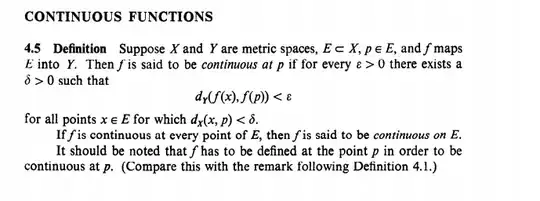Can functions with domain in the Natural Numbers be continuous? In the high school, it is teached an intuitive notion of continuous functions: functions which will always appear as an "unbroken curve", no matter how close one zooms in the graph. This would be the opposite of discrete functions, which would appear as "dots" if one zooms close enough.
In Analysis, this intuitive notion is abandoned to make way for formalism. Rudin, in "Principles of Mathematical Analysis" defines continuous functions as it follows:
Which, for me, can be written in formal language as:
$\forall\varepsilon>0\quad\exists\delta>0 \quad\forall x \in E\quad ((d_{x}(x,p)<\delta)\implies(d_{y}(f(x),f(y))<\epsilon))$
Functions with domain in the natural numbers will appear as dots in a graph, instead of an unbroken curve.
I am trying to formally prove that no function with domain on the Naturals is continuous, can somebody help me out?
PS: What is the domain of $\varepsilon$ and $\delta $?
